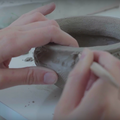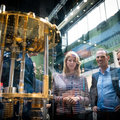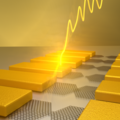Archive
24 October 2018
Efficient separation of CO2 and hydrogen with new membrane
Researcher Meixia Shan has developed and tested a new polymer membrane that separates CO2 and hydrogen very efficiently. On October 24th Shan, who has already published about this new membrane in Science Advances, defends her PhD-thesis on this subject at TU Delft.
23 October 2018
Former Applied Physics student Ad Bax receives prestigious chemistry award
During the 2018 Welch Conference on Chemical Research, on 22 October 2018, Adriaan (Ad) Bax was presented with the prestigious Welch Award in Chemistry. Bax, who works at one of the American National Institutes of Health, is a former student and PhD candidate of Delft University of Technology. He studied Applied Physics.
19 October 2018
Art from wastewater at the Dutch Design Week

This week, three young designers and the Dutch water boards present Dutch Design made from 'Kaumera'. Kaumera is a new raw material that can be extracted from waste water by means of the Nereda purification process, which was developed in part by TU Delft. All three artists found a different application for the versatile raw material: in porcelain, textiles and woodwork. During the Dutch Design Week, from 20 to 28 October, the exhibition can be seen in the Veemgebouw (stand EFGF).
18 October 2018
QuTech researchers put forward a roadmap for quantum internet development

A quantum internet may very well be the first quantum information technology to become reality. Researchers at QuTech in Delft, The Netherlands, today published a comprehensive guide towards this goal in Science.
08 October 2018
Finnish Quantum company Bluefors starts R&D site on Delft Campus

On 4 October during the Innovation Expo in Rotterdam, the Finnish company Bluefors announced that it will join the Delft quantum technology community and open an R&D office on the TU Delft campus.
05 October 2018
Ballistic graphene Josephson junctions enter microwave circuits
Superconducting quantum microwave circuits can function as qubits, the building blocks of a future quantum computer. A critical component of these circuits, the Josephson junction, is typically made using aluminium oxide. Researchers in the Quantum Nanoscience department at the Delft University of Technology have now successfully incorporated a graphene Josephson junction into a superconducting microwave circuit. Their work provides new insight into the interaction of superconductivity and graphene and its possibilities as a material for quantum technologies.
04 October 2018
TU Delft measurement technique shown to reveal important properties of quantum dots

Scientists have demonstrated that the positrons produced by the TU Delft research reactor are ideally suited for studying quantum dots, the building blocks of next generation solar cells.
28 September 2018
NWO-groot grant for brain imaging centre CUBE

NWO has approved an application for the Center for Ultrasound Brain Imaging at Erasmus MC (CUBE), in which TU Delft is also involved. The science financier has earmarked nearly 2.5 million euros for the realization of CUBE.
25 September 2018
Hyun Youk joins CIFAR Global Scholars network

Hyun Youk (Bionanoscience) has been selected as one of the 12 early career researchers who will join the CIFAR Azrieli Global Scholars program. Youk will receive a prestigious two‐year term with 100,000 dollar in research support.
18 September 2018
Graphene tunnelling junctions: beyond the breaking point

Molecular electronics is a burgeoning field of research that aims to integrate single molecules as active elements in electronic devices. Obtaining a complete picture of the charge transport properties in molecular junctions is the first step towards realizing functionality at the nanoscale. Researchers from Delft University of Technology have now studied the charge transport in a novel system, the ‘graphene mechanical break junction’, which for the first time allowed direct experimental observation of quantum interference effects in bilayer graphene as a function of nanometer-displacements. This new platform could potentially be used for electronic fingerprinting of biomolecules, from DNA to proteins, which in turn can have important implications for the diagnosis and treatment of diseases. The research was partly funded by the Graphene Flagship.